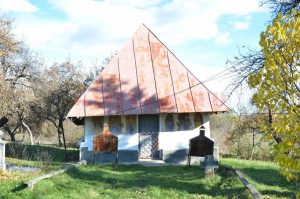

Saint Parascheva church was built in the period 1935 – 1958 through the contributions brought by the inhabitants from Strehaia and the ones from the neighboring communes. The place of worship was consecrated on the 2nd of November 1958 by Emilian, Archbishop of Craiova and Metropolitan of Oltenia, President of the Great National Gathering being Ion Mauer, President of the Council of Ministers, Chivu Stoica, Archpriest and Congregation Priest T. N. Drăghici.
Strehaia is a city formed from the localities Ciochiuța, Comanda, Hurducești, Lunca Banului, Slătinicu Mare, Slătinicu Mic and Strehaia and from the villages Menți, Motruleni and Stăncești. It has a population of 11.846 inhabitants. Strehaia is situated at 25 km from Filiași on the border of the river Motru in the north – west part of the Piemontul Bălăciței (or the Platform of Strehaia), at 140 – 160 m altitude, on the inferior terraces of confluence of the river Hușnița with Motru.
It is an establishment reminded in the documents dating back to the XIVth century.
Inferiorly developed, under the demographic point of view, the establishment was noticed because of its role played in the country’s history. In the XIVth century (1375 – 1377, 1382) and 1384 – 1390, Strehaia was the residence of Bănie. Between 1479 and 1495 here was the residence of Neagoe Ban Strehaianul. At the end of the XVth century, Strehaia was the residence of the Episcopacy from Severin, founded by Vlaicu Vodă in 1370. Its headquarters was situated in the small ban of Mehedinți, the great Prince Michael the Brave. In 1645, Matei Basarab, prince of Wallachia, founded outside the old fireplace, the Church of the Strehaia Monastery and the aristocratic palace.
The contribution of Brâncoveanu (also a descendant from the Craiovești) is certified by the inscription discovered by the professor Maria Voica Pușcașu on the occasion of the digging performed in the years 1963 – 1964 in the premise of the monastery, inscription which is situated at the History Museum of the “Michael the Brave” school.
In the medieval period, it was, for a short period of time, the residence of the ban, which was moved from Drobeta Turnu – Severin, because of the frequent Turkish attacks. However, Bănia was moved, again, in a relatively short period of time, at Craiova.
Since then, Strehaia remained a locality preponderantly agricultural.
The former congregation residence and even ban chair, the city was in 1821 the witness of the fights of the pandours of Tudor Vladimirescu with the Princely Posse.
The locality is known through its old cow market, mentioned even before the year 1653.
It is an important railway and roadway node. Commercial and cultural centre, with some administrative functions, in Strehaia there are founds unities of the industry (ready-made clothes, consummation coop, etc.).


